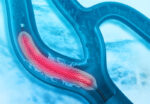The octogenarian population has already reached 137 million and continues to grow. It is estimated to triple by 2050. This increase represents a big challenge, seeing as these patients are often more fragile, present more complex coronary artery disease and multiple comorbidities. This generally requires two or more procedures and more experience both from operators...
EuroPCR 2024 | Influence and Effect of CAD Physiopathological Patterns in the Safety and Efficacy of PCI
Coronary revascularization aims at improving coronary flow. However, after successful percutaneous coronary intervention (PCI) a significant number of patients might experience suboptimal coronary physiology. It has been observed that low fractional flow reserve (FFR) after PCI is associated to poor prognosis. Also, improved FFR after procedure directly correlates with improved angina symptoms. Pullback pressure during...
Artificial Intelligence in Complex PCI Cases – 2nd International Symposium of Cardiology
The Latin American Society of Interventional Cardiology invites the whole community to take part in the 2nd International Symposium of Cardiology entitled “Artificial Intelligence in Complex PCI Cases”. The event will feature life case streaming and reputed international keynote speakers, and will be held on May 17 – 18, 2024, at Clinica Imagem’s Auditorium (Rua...
PCI Evolution in Infiltrative Diseases
Infiltrative diseases (ID) consist of a heterogeneous series of genetic conditions that cause infiltration and extracellular deposits which alter the diverse systems and organs affected. Amyloidosis, sarcoidosis and hemochromatosis affect the heart, altering the myocardium and the conduction system. PCI is often used at present to treat heart disease, and some of these patients present...
Contemporary Outcomes of CTO PCI in Europe: The ERCTO Registry
Roughly 20% or coronary angiographies show some form of chronic total occlusion (CTO), and this figure is twice as high for diabetic patients or those with cardiac failure and reduced ejection fraction (EF). CTO percutaneous intervention (PCI) has experienced a significant growth thanks to the development of new techniques and dedicated material. However, a considerable...
Precision PCI with HD Imaging for Calcified MVD | SOLACI-SBHCI 2023 – National Live Case
✔️ SOLACI-SBHCI 2023 – National Live Case | Precision PCI with HD imaging for calcified MVD ✔️ Site; INSTITUTO NACIONAL DE CARDIOLOGIA (INC) ✔️ August 3, 2023, Copacabana Room, Windsor Oceánico
Left Main PCI with Dedicated DES Guided by HD Imaging | SOLACI-SBHCI 2023, International Live Case
✔️ SOLACI-SBHCI 2023 – Internationl Live Case | Left Main PCI with Dedicated DES Guided by HD Imaging ✔️ Site: LEIPZIG HEART CENTER – LEIPZIG, GERMANY ✔️ August 3, 2023, Copacabana Room, Windsor Oceánico
Use of IVUS in Complex PCI: Results according to Operator Experience
The use of ultravascular ultrasound (IVUS) to guide coronary angioplasty procedures (PCI) has been shown to reduce the risk of major adverse events in numerous randomized controlled studies, registries and meta-analysis. The current guidelines recommend the use of IVUS in left main disease and complex lesions. The proportion of complex PCI procedures has increased over...
iFR Guided PCI to the LAD: Same as for non-LAD Vessels?
iFR has been validated as a useful tool for intermediate lesion analysis, with the advantage of not requiring the use of drugs. On the other hand, its use for PCI outcome assessment has not yet been thoroughly looked into, even though there have been promising data. 24% of DEFINE PCI cases presented ≤0.89 iFR with...
Optimal Duration of DAPT with Oral Anticoagulation After PCI?: 1 Month vs. 3 Months
While the benefits of dual antiplatelet therapy (DAPT) with aspirin and a P2Y12 inhibitor are recognized, its primary complication is the occurrence of bleeding events, which negatively impact patient morbidity and mortality. Additionally, about 10% of patients undergoing percutaneous coronary intervention (PCI) are on oral anticoagulant therapy, which significantly increases the risk of bleeding when...








